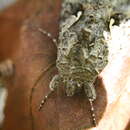Conservation Status
provided by University of Alberta Museums
A widespread, common species, and a crop pest south of Alberta. No concerns.
- license
- cc-by-nc
- copyright
- University of Alberta Museums
Cyclicity
provided by University of Alberta Museums
Adults are collected occasionally in late May, but the main flight is from late July through October
- license
- cc-by-nc
- copyright
- University of Alberta Museums
Distribution
provided by University of Alberta Museums
A western species, found from northern Mexico to Alaska, east to Manitoba, South Dakota, Kansas and New Mexico. It is a common and widespread species in Alberta, north in the Foothills, Grasslands and Aspen Parklands region and into the southern Boreal Forest.
- license
- cc-by-nc
- copyright
- University of Alberta Museums
General Description
provided by University of Alberta Museums
A medium-size (3.6-4.2 cm wingspan) grey-black moth with a silvery sheen in fresh specimens. Forewings are mottled pale grey in the basal and subterminal areas, with dark blackish-brown in the lower median area and along the subterminal line. The antemedian and postmedian lines and the area below the stigma are dark red-brown. Stigma is silvery white, forming an outward curving arc with a rounded tip and with a widely separated fork at the upper end. About one-third of the way down the subterminal line is a black dash which connects the subterminal and postmedian lines. This black dash is diagnostic and will separate californica from the very similar A. pseudogamma. Hindwings are dark sooty brown-black, paler in the basal half and shading into a wide dark terminal band. The antennae are simple and both the sexes are alike.
- license
- cc-by-nc
- copyright
- University of Alberta Museums
Habitat
provided by University of Alberta Museums
Open meadows, hayfields, croplands, gardens and woodland edges.
- license
- cc-by-nc
- copyright
- University of Alberta Museums
Life Cycle
provided by University of Alberta Museums
Adults are both noctural and diurnal, and have been collected in light traps as well as while nectaring during the day. In late fall, they can be quite common and found nectaring during the afternoon at late blooming plants such as Alfalfa and garden Marigolds. It appears that there is a small spring emergence and a much larger late summer and fall generation in Alberta.
- license
- cc-by-nc
- copyright
- University of Alberta Museums
Trophic Strategy
provided by University of Alberta Museums
No Alberta data. A pest on a variety of forage and vegetable crops further south, and probably also a variety of native herbaceous plants. Eichelin and Cunningham (1978) list over 50 genera in over 25 families of herbaceous plants and woody shrubs used as hosts by larvae of californica.
- license
- cc-by-nc
- copyright
- University of Alberta Museums
Autographa californica
provided by wikipedia EN
Autographa californica, the alfalfa looper, is a moth of the family Noctuidae. The species was first described by Adolph Speyer in 1875. It is found in western North America from southern British Columbia to Baja California and to Manitoba, South Dakota, Colorado and New Mexico.
The wingspan is 36–42 mm. The moth flies from July to October depending on the location.
The larvae feed on a wide range of plants. Recorded food plants include species of families Apiaceae, Aquifoliaceae, Asteraceae, Boraginaceae, Brassicaceae, Caprifoliaceae, Chenopodiaceae, Cucurbitaceae, Ericaceae, Eschscholzia, Fabaceae, Grossulariaceae, Liliaceae, Lamiaceae, Linaceae, Malvaceae, Plantaginaceae, Poaceae, Podocarpaceae, Polygonaceae, Rhamnaceae, Rosaceae, Rutaceae, Scrophulariaceae, Solanaceae and Verbenaceae.

- license
- cc-by-sa-3.0
- copyright
- Wikipedia authors and editors
Autographa californica: Brief Summary
provided by wikipedia EN
Autographa californica, the alfalfa looper, is a moth of the family Noctuidae. The species was first described by Adolph Speyer in 1875. It is found in western North America from southern British Columbia to Baja California and to Manitoba, South Dakota, Colorado and New Mexico.

Caterpillar
The wingspan is 36–42 mm. The moth flies from July to October depending on the location.
The larvae feed on a wide range of plants. Recorded food plants include species of families Apiaceae, Aquifoliaceae, Asteraceae, Boraginaceae, Brassicaceae, Caprifoliaceae, Chenopodiaceae, Cucurbitaceae, Ericaceae, Eschscholzia, Fabaceae, Grossulariaceae, Liliaceae, Lamiaceae, Linaceae, Malvaceae, Plantaginaceae, Poaceae, Podocarpaceae, Polygonaceae, Rhamnaceae, Rosaceae, Rutaceae, Scrophulariaceae, Solanaceae and Verbenaceae.
- license
- cc-by-sa-3.0
- copyright
- Wikipedia authors and editors


 Caterpillar
Caterpillar